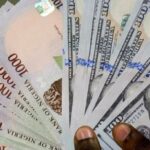The prices of food commodities in the country rose by 40.53 per cent in the month of April, data from the National Bureau of Statistics (NBS) has shown.
NBS said the rise was 15.92 per cent points higher compared to the rate recorded in April, 2023 (24.61 per cent).
The report said the increase was influenced by increases in the prices of “millet flour, garri, bread, wheat flour (prepacked), semovita (which are under bread and cereals class), yam tuber, water yam, coco yam (under potatoes, yam and other tubers class), coconut oil, palm kernel oil, vegetable oil, etc (under oil and fat), dried fish sardine, catfish dried, mudfish dried (under fish class), beef head, beef feet, liver, frozen chicken (under meat class), mango, banana, grapefruit (under fruit class), Lipton tea, Bournvita, Milo (under coffee, tea and cocoa class).”
NBC, however, said the prices were down when compared to the month of March, as they increased by 2.50 per cent, which showed a 1.11 per cent decrease compared to the rate recorded in March, 2024 (3.62 per cent).
- Residents commend FCTA for evacuating waste from Karu cemetery
- Rivers crisis: 5 pro-Wike commissioners quit Fubara’s cabinet
It attributed the reduction to the fall in the rate of increase in “the average prices of yam, water yam, Irish potatoes (under potatoes, yam & other tubers class), beer, local beer (under tobacco class), Milo, Bournvita, Nescafe (under coffee, tea, and coco class), groundnut oil, palm oil (under oil and fats class), egg, fresh milk, powdered milk, tin milk (under milk, cheese, and eggs class), soft drinks e.g. malt Guinness, Coca-Cola, etc, wine and fruit e.g., water melon, pineapple, banana, pawpaw, etc.”
The increase was despite Nigeria’s currency recording gains against the dollar in April.
Recall that the naira appreciated to N1,200 to a dollar in April, after crashing to over N1,600.
But Nigerians have complained that the appreciation did not reflect in the prices of goods and services which continued an upward trajectory.
On states’ profiles, the report said the highest increase, year-on-year, was in Kogi (48.62 per cent), Kwara (46.73 per cent), Ondo (45.87 per cent), while Adamawa (33.61 per cent), Bauchi (33.85 per cent) and Nasarawa (34.03 per cent) recorded the slowest rise. On a month-on-month basis, however, the highest was in Lagos (4.74 per cent), Edo (4.06 per cent), and Yobe (3.99 per cent), while Kano (0.47 per cent), Adamawa (0.98 per cent) and Zamfara (1.50 per cent) recorded the slowest.
Also, the report stated that headline inflation was 33.69 per cent when compared to March, 2024, which was 33.20 per cent.
It noted that the movement of inflation in April, showed an increase of 0.49 per cent points when compared to the March, 2024, headline inflation rate.
MPC needs to soften monetary stance
— Expert
Reacting to the report, the CEO of the Centre for the Promotion of Private Enterprise (CPPE), Dr Muda Yusuf, said the persistent inflationary pressures in the economy remained a major cause for concern because of the implications for purchasing power and operating costs for businesses.
While noting that there was a decline in the month-on-month inflation both for headline inflation and food inflation, he said the key inflation drivers were yet to significantly moderate.
He said, “These include the naira exchange rate, transportation costs, logistics challenges, insecurity in farming communities and structural bottlenecks to production. These are largely supply-side issues which are being addressed by the fiscal authorities.”
While urging the Central Bank of Nigeria (CBN) to peg the dollar rate at between N800 and N1,000, he noted that the move was important to reduce the pass-through effect of heightening trade cost on inflation.
He added that the exchange rate computation of import duty continued to be a major concern to businesses as it had become a major inflation driver and that the Monetary Policy Committee (MPC) should soften its monetary tightening stance for the time being.
He further said, “Businesses are yet to recover from the shocks of the recent bullish rate hikes. The monetary instruments should be put on pause while fiscal policy tools address supply side factors in the inflation dynamics.”




